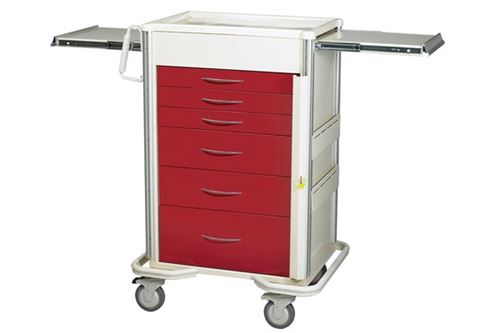-
Home
-
Hospital Crash Carts: An Overview
Hospital Crash Carts: An Overview
November 9, 2023
 In a medical emergency, time is of the essence, which is why every hospital needs fully stocked and well-organized crash carts. A crash cart, also called an emergency cart or a code cart, is a portable wheeled cabinet that contains all the necessary equipment and medications used during critical care situations. A crash cart can help save a life in an emergency, so it’s crucial that they are always well-stocked and ready to go.
In a medical emergency, time is of the essence, which is why every hospital needs fully stocked and well-organized crash carts. A crash cart, also called an emergency cart or a code cart, is a portable wheeled cabinet that contains all the necessary equipment and medications used during critical care situations. A crash cart can help save a life in an emergency, so it’s crucial that they are always well-stocked and ready to go.
What is in a Hospital Crash Cart?
Every hospital crash cart needs to have specific equipment and medications ready for use in case of an emergency. The contents of a crash cart may vary from institution to institution, but some commonly stocked items include:
- Airway Management Tools are devices and techniques used by healthcare professionals to establish and maintain a patient's airway during medical procedures or in emergency situations. These tools, such as endotracheal tubes and laryngoscopes, ensure that the patient can breathe adequately and receive oxygenation effectively.
- Cardiac Management Equipment refers to the devices and tools used to diagnose, monitor, and treat various cardiac conditions such as defibrillators, ECG monitors, and electrodes. This equipment helps healthcare professionals assess the heart's function, detect abnormalities, and provide appropriate interventions.
- Medications and Medication Equipment may vary based on the specific protocols and guidelines of each healthcare facility.
- Resuscitation Tools are devices used to assist in the process of cardiopulmonary resuscitation (CPR) and the resuscitation of patients who are in cardiac arrest or experiencing respiratory distress. These tools help maintain airway patency, provide ventilation support, and facilitate effective chest compressions.
- Vascular Access Supplies are medical devices and equipment, such as IV catheters, syringes, and saline flush. They are used to establish access to a patient's blood vessels for the purpose of delivering fluids, administering medication, or performing diagnostic procedures.
How is a Crash Cart Organized?
Since time is of the essence in an emergency, organizing a crash cart is just as important as making sure it is fully stocked. To save time, the cart should be organized according to the tasks that need to be done during a medical emergency. All items should be clearly labeled, and the cart should be checked on a regular basis to ensure that all supplies are up-to-date and not expired. This approach minimizes response time and optimizes the overall workflow, enabling healthcare providers to deliver the highest standard of medical assistance in critical situations.
How Many Crash Carts Should a Hospital Have?
The number of crash carts a hospital should have depends on the hospital’s size and patient population. Smaller hospitals with fewer beds may only need a few crash carts, while larger hospitals with more patients may need many. It’s also important to note that crash carts should be strategically placed throughout the hospital, so they can be quickly accessed during an emergency.
How Often Should Hospital Crash Carts Be Checked?
Regularly checking and maintaining your hospital crash cart is crucial for ensuring preparedness in emergency situations. Proper maintenance ensures that all necessary equipment and supplies are readily available, functional, and within their expiration dates, allowing healthcare providers to respond quickly and effectively when every second counts.
Medical instruments should always be sterilized, hygienic, and ready to use in an emergency. As such, according to regulatory guidelines, hospital crash carts should be checked at least once every month. Hospitals should also have a crash cart standard operating procedure in place, specifying how often the carts must be checked, stocked, and maintained. For further details on this topic, visit The Importance of Regular Medical Cart Inspections.
In life-threatening situations, having quick access to the proper equipment and supplies is essential. Crash carts, when properly maintained and stocked, can help improve efficiency and facilitate better outcomes in an emergency.